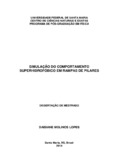| dc.creator | Lopes, Daisiane Molinos | |
| dc.date.accessioned | 2021-08-17T18:24:15Z | |
| dc.date.available | 2021-08-17T18:24:15Z | |
| dc.date.issued | 2014-08-28 | |
| dc.identifier.uri | http://repositorio.ufsm.br/handle/1/21976 | |
| dc.description.abstract | We present a two-dimensional simulation based on the cellular Potts model
(CPM) of the properties of smooth and pillar structured hydrophobic surfaces. For a
surface having superhidrophobic behavior, a drop of water deposited on it should have:
(I) high-value of contact angle ( ), (II) low hysteresis ( <10°) and (III) high
sliding speed. Using a smooth surface with hydrophobic character we modify its
structure for the purpose to obtain a surface with superhydrophobic character. On this
structured surface with pillars we varied the distance (b) and the height of the pillars
(h) to analyze how these parameters can influence the superhydrophobic
phenomenon. We also analyzed how the parameter (related to the inverse of the
compressibility of the liquid), the parameter fluctuation (T) and gravity interfere in the
system. We observed that the contact fraction (f) between the liquid and the solid has
strong influence on superhydrophobicity as mentioned in items I, II and III above. This
study was able to determine a region of values f, where superhydrophobic behavior is
intensified, i.e, I, II and III are satisfied. In the study of state transition we analyze how
the variation of the model parameters influence the passage from Cassie to Wenzel
states. The results obtained in our simulations are consistent with experimental results
found in literature. | eng |
| dc.language | por | por |
| dc.publisher | Universidade Federal de Santa Maria | por |
| dc.rights | Attribution-NonCommercial-NoDerivatives 4.0 International | * |
| dc.rights.uri | http://creativecommons.org/licenses/by-nc-nd/4.0/ | * |
| dc.subject | Física | por |
| dc.title | Simulação do comportamento superhidrofóbico em rampas de pilares | por |
| dc.title.alternative | Simulation behaviour of superhydrophobic in ramps pillars | eng |
| dc.type | Dissertação | por |
| dc.description.resumo | Neste trabalho apresentamos uma simulação bidimensional baseada no
modelo celular de Potts (CPM) sobre as propriedades de superfícies hidrofóbicas lisas
e estruturada em pilares. Para que uma superfície tenha um comportamento
superhidrofóbico, uma gota de água depositada sobre ela deverá ter: (I) alto valor do
ângulo de contato (� > 150°), (II) baixa histerese do ângulo de contato (∆� < 10°) e
(III) alta velocidade de deslize. Utilizando uma superfície lisa com caráter hidrofóbico,
modificamos a sua estrutura com o objetivo de obtermos uma superfície com caráter
superhidrofóbico. Estruturamos essa superfície com pilares e variamos a distância (b)
e a altura dos pilares (h) para analisar como esses parâmetros podem influenciar no
fenômeno da superhidrofobicidade. Ainda analisamos como o parâmetro �
(relacionado ao inverso da compressibilidade do líquido) o parâmetro de flutuação (T)
e a gravidade interferem no sistema. Observamos que a fração de contato entre o
sólido e o líquido (�) tem forte influência sobre a superhidrofobicidade como
mencionado nos itens I, II e III acima. Desse estudo foi possível determinar uma
região de valores de �, onde o comportamento superhidrofóbico é intensificado, ou
seja I, II e III são satisfeitos. No estudo da transição de estados analisamos como a
variação dos parâmetros do modelo influenciam na passagem de Cassie para Wenzel.
Os resultados obtidos em nossas simulações são coerentes com os resultados
experimentais encontrados na literatura. | por |
| dc.contributor.advisor1 | Mombach, Jose Carlos Merino | |
| dc.contributor.advisor1Lattes | http://lattes.cnpq.br/7661373078999069 | por |
| dc.contributor.referee1 | Thomas, Gilberto Lima | |
| dc.contributor.referee2 | Villetti, Marcos Antonio | |
| dc.creator.Lattes | http://lattes.cnpq.br/7262730172725803 | por |
| dc.publisher.country | Brasil | por |
| dc.publisher.department | Física | por |
| dc.publisher.initials | UFSM | por |
| dc.publisher.program | Programa de Pós-Graduação em Física | por |
| dc.subject.cnpq | CNPQ::CIENCIAS EXATAS E DA TERRA::FISICA | por |
| dc.publisher.unidade | Centro de Ciências Naturais e Exatas | por |



